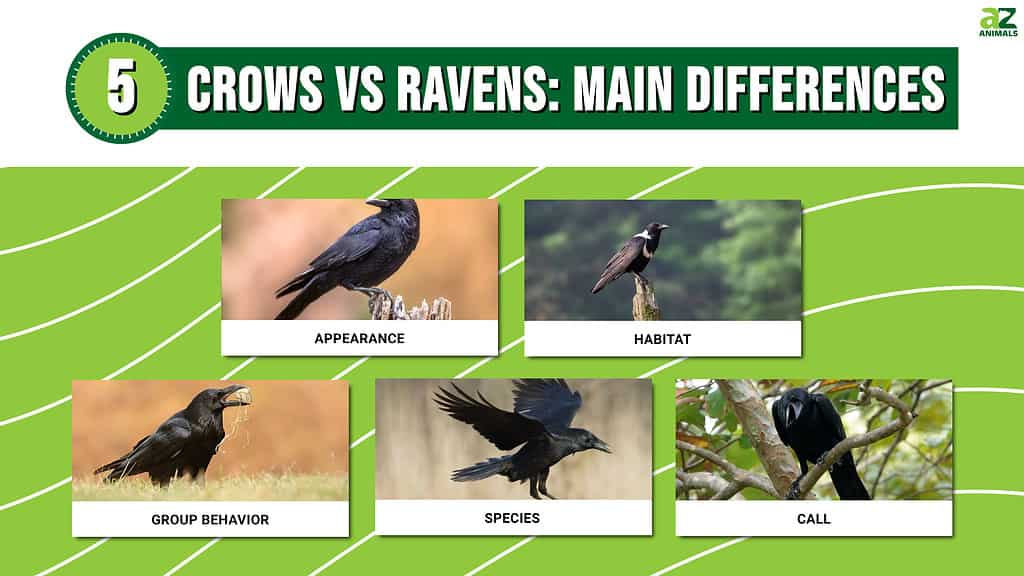
Crows and ravens are often confused with each other. In comparison, there are enough similarities in physical features and terminology to believe that these birds are, in fact, the same. However, when you take a closer look at raven vs crow, there are key differences in their behavior and specific body parts which you can only recognize through observation even from a distance. Each bird also inhabits different areas and has its own symbolism in various mythologies.
They are in fact two different species of the genus Corvus, making them both corvids. Although the comparison is generally true between all crows vs ravens, for the sake of simplicity, the differences will be mainly between the common raven and the American crow.
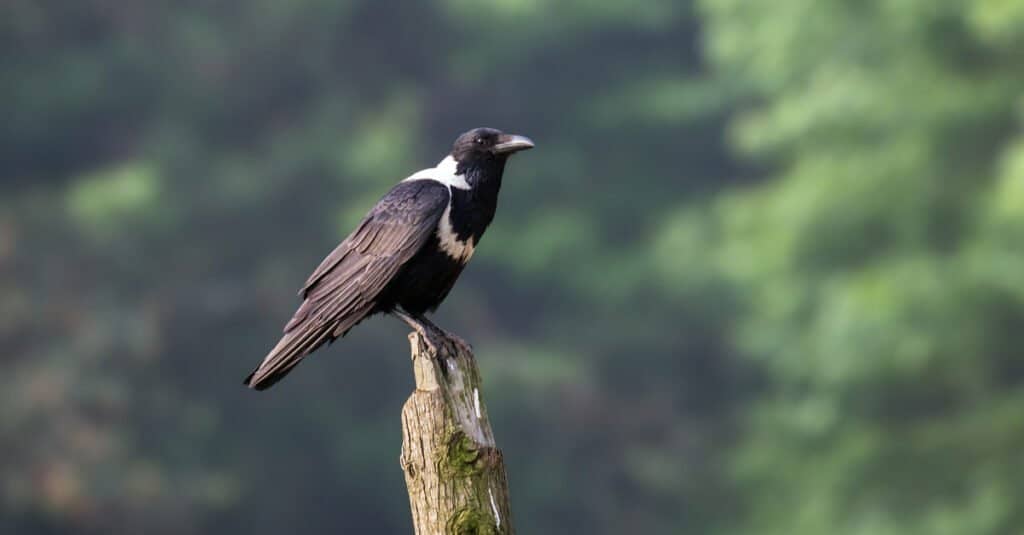
Some species of raven and crow have white collars around their neck and chest.
©Agami Photo Agency/Shutterstock.com
Let’s make an in-depth comparison of raven vs crow below!
Comparing Raven vs Crow
| Category | Crows | Ravens |
|---|---|---|
| Size | The size of a rock pigeon | The size of a red-tailed hawk |
| Appearance | Smaller, straighter beak, blunt, fan-shaped tail, splayed wings | Larger, curved beak, wedge-shaped tail, and pointed wings, shiny feathers |
| Habitat | Urban areas | Wilder, rural areas |
| Diet | Mice, nestlings, eggs, frogs, earthworms, mollusks, seeds, fruits, and nuts | Carrion, garbage and small invertebrates, amphibians, reptiles, and mammals |
| Intelligence | Clever; intelligence of 7-10-year-old child; can use tools and remember faces | Playful and cunning; can do as well as on intelligence tests as crows if not better; can make future plans for food and trade for it |
| Symbolism | Death and war symbolism (Irish); ancestral (Australian); protector of Dharma (Buddhism); trickster spirit (indigenous) | Deity (indigenous); the symbolism of omens or deity incarnation (Irish) |
| Group behavior | A group of 3 or more, called a murder | Solitary or in pairs |
| Species | A species of the genus Corvus | A species of the genus Corvus |
| Lifespan | 7-8 years | 10-30 years |
| Call | Caw | Gronk or croaking sound |
The 5 Key Differences Between Raven vs Crow
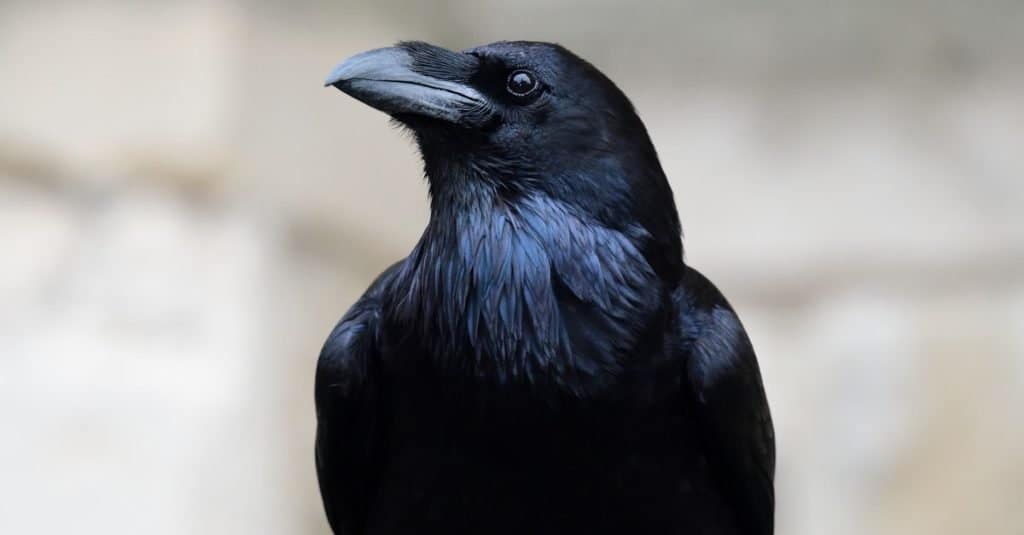
Common ravens tend to travel alone, unlike their flock-dwelling counterpart the crow.
©iStock.com/Tom Meaker
- Appearance: In a comparison of size, crows are generally smaller than ravens. However, there are some large crows and small ravens. Hence, the best way to distinguish a crow vs. a raven is by looking at the appearance of its beak, wings, and tail. Crows have a purple or green tint on blunt, splayed wings, while ravens have shiny feathers with blue or purple-tinted or grey and brown-tinted, pointed wings. Crows have fan-shaped tails and smaller, straighter beaks, whereas ravens have wedge-shaped tails with larger, curved beaks with a tuft of hair on top. When the crow fluffs its feathers, it looks like a mane or ruff and the raven’s feathers look ragged. The raven’s neck also looks longer in flight.
- Habitat: Crows are more social and inhabit human-populated areas such as cities. Ravens prefer wilder areas and the countryside, where there are fewer people and they are likely to find carrion and small animals to eat, being more scavengers than hunters.
- Group behavior: Crows tend to socialize in groups, and a group of crows is called a murder. Ravens prefer to be solitary or travel in pairs. Crows help each other raise babies, whereas ravens do not. They are also more likely to form bonds with humans and are a partly migratory species, unlike ravens. Crows can defeat ravens in flocks, although ravens are stronger.
- Species: “Crow” refers to any bird of the genus Corvus which includes crows, ravens, jays, and magpies, but it is also a particular species in that genus. “Raven” is the type species of the genus Corvus, having a larger distribution over the Northern Hemisphere than any other corvid species.
- Call: The crow’s call is a caw-caw sound that usually starts with one loud “caw” followed by several shorter caws. It’s very different than the long gronk or croaking sound of the raven. However, while the raven’s call is deep and guttural, the crow’s call is louder but higher-pitched and nasal.
Physical Appearance Raven vs Crow

Crows can be easily discerned from ravens by their fan-like tails.
©iStock.com/CreativeNature_nl
Ravens are generally larger than crows. They are longer and weigh more. Ravens also have greater wingspans than crows. When in flight, their necks will appear longer. Not only are their necks longer, but ravens also will tend to fluff their feathers into a main whereas a crow will not. Raven tails are also different than crows and can be seen clearly when in flight.
Ravens have pointed wings and wedge-shaped tails. However, crows will have a splayed wingspan and fan-shaped tails.
Intelligence Raven vs Crow
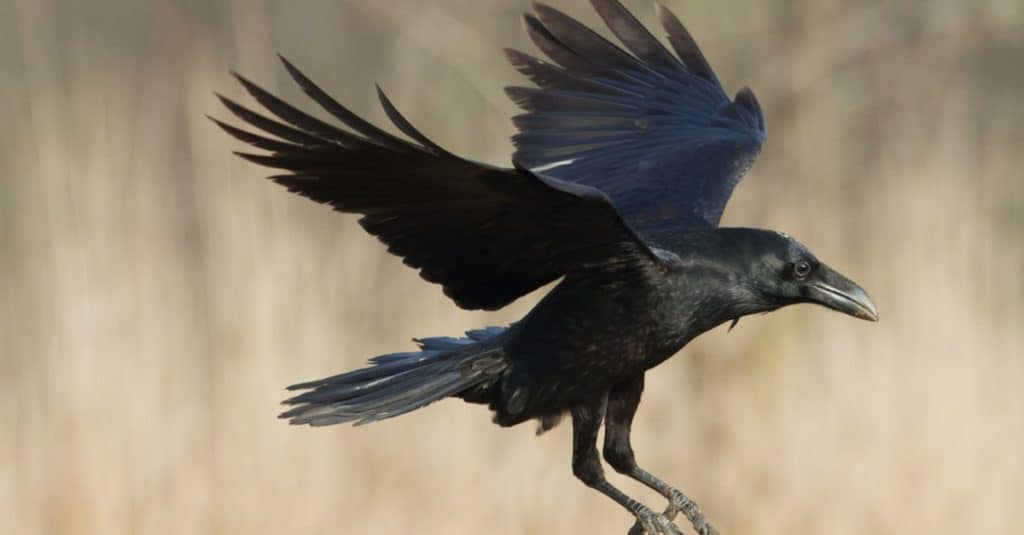
Ravens and crows are both some of the smartest birds.
©Marcin Perkowski/Shutterstock.com
Crows are highly intelligent creatures and are known to devise ways of getting food and surviving in the city or urban environments. In fact, researchers found that for certain water displacement tasks, crows perform as well as 7 to 10-year-old humans. Crows can also form special relationships with humans who feed them regularly. For example. crows have been known to bring shiny gifts in exchange for food from people.
For intelligence, Ravens vs crows are similar, however, ravens are brainy birds and can perform just as well as chimpanzees and orangutans across tasks designed to measure the depth of intelligence in a creature. It is safe to say that there is very strong evidence to say that the tasks used to measure raven’s intelligence prove ravens are just as smart as great apes. Additionally, ravens are fantastic mimickers and are known to mimic human voices and tones.
Cultural
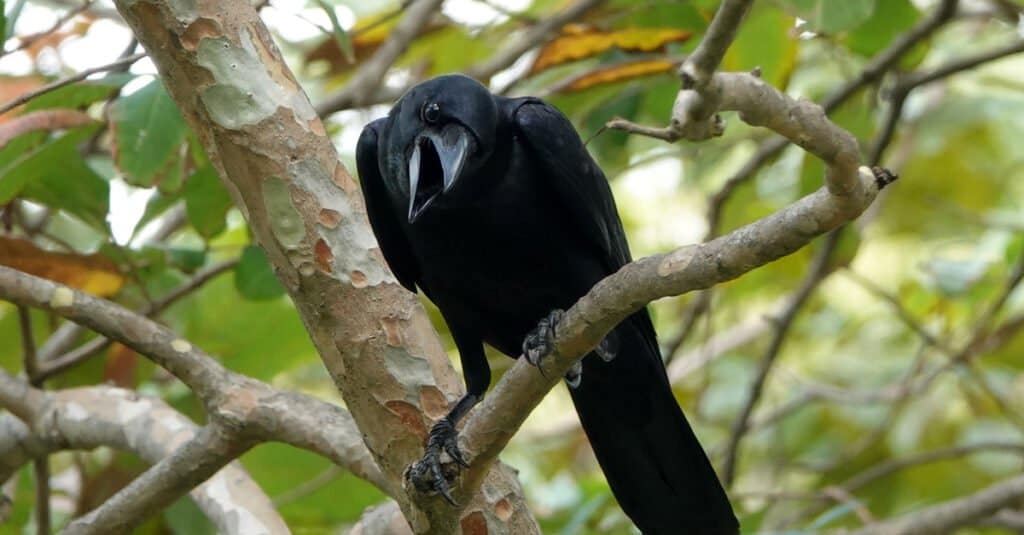
Different cultures interpret crow sightings in a variety of ways, both positive and negative.
©Marut Sayannikroth/Shutterstock.com
As mentioned before, ravens and crows are both symbolic and even sacred to many cultures. Crows are thought to represent change and transformation, specifically emotionally and spiritually. On the other hand, ravens can be perceived as bad omens but are also believed to be all-knowing, possibly relating to healing and longevity.
Symbolism in Raven vs Crow
In the symbolism of crow vs. raven, the British/Irish culture often portrays the crow as a symbol of death or war. For example, in a classic folk song written by British songwriter Sydney Carter called The Crow on the Cradle, he utilizes the crow as a character to prophesize the impending doom of war, as demonstrated in the following two verses:
“The crow on the cradle, the black and the white,
O somebody’s baby is born for a fight.
The crow on the cradle, the white and the black,
O somebody’s baby is not coming back,
Sang the crow on the cradle.
Your mother and father, they’ll sweat and they’ll save;
To build you a coffin and dig you a grave.
Hushabye, little one, never you weep?
For we’ve got a toy that will put you to sleep,
Sang the crow on the cradle.”
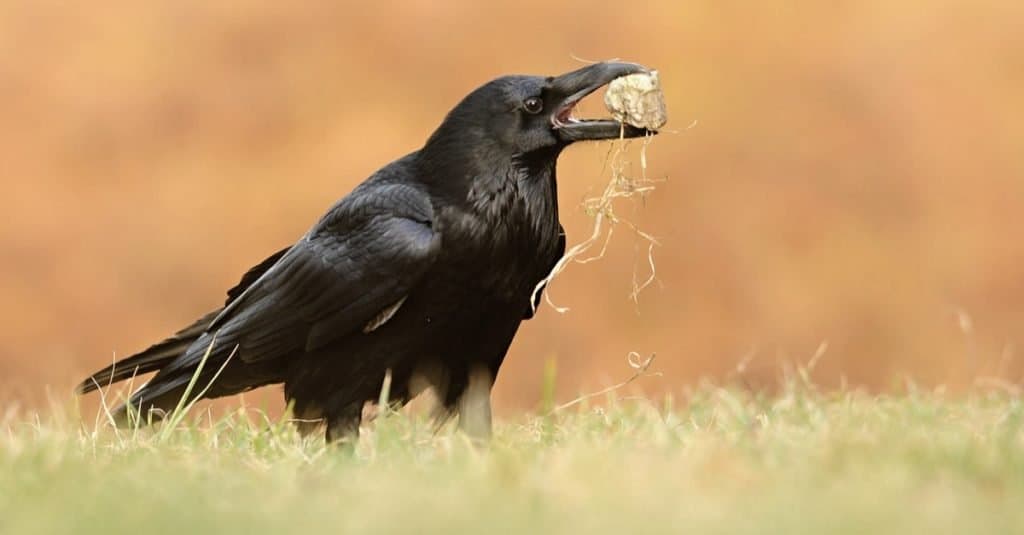
Ravens inspired one of the most popular poems in American literature.
©Michal Pesata/Shutterstock.com
Ravens are often set up as deities and also used as omens. The most famous example of the raven being used in more modern literature is in the poem by Edgar Allen Poe The Raven. The raven character is a talking bird that only says the word “nevermore” to the narrator, who quizzes the bird on whether or not he’ll be reunited with his lost love. He takes the raven’s responses as a dark foretelling that he will be eternally separated.
Lifespan of Crows and Ravens
The average life expectancy for crows and ravens varies considerably from species to species. For the most part, crows live about 5-15 years in the wild depending on the type of crow. The oldest reported crow in captivity was the 59 year old Tata who lived through 11 US Presidencies and passed away in 2006.
Ravens typically live about as long as crows with 10-20 years being their average lifespan. Reports of ravens who have lived to be 70 or 80 years old have been put forward, but scientists are skeptical as they have not been able to verify these claims.
The photo featured at the top of this post is ©
FAQs (Frequently Asked Questions)
Are Ravens as smart as crows?
Ravens do as well as crows on intelligence tests. Birds in the genus Corvus are some of the most intelligent birds in the world, second only to the parrot.
How big is a raven compared to a crow?
Generally, a raven is larger than a crow. In a comparison of the common raven and the American crow, the raven has a weight of 40 ounces with a length of about 21 to 27 inches and a wingspan of 45 to 54 inches, whereas the crow has a weight of 20 ounces with a length of 16 to 21 inches and a wingspan of 30 to 40 inches.
What are 3 crows called?
A murder.
Are Ravens louder than crows?
No, crows are louder than ravens.
Thank you for reading! Have some feedback for us? Contact the AZ Animals editorial team.






